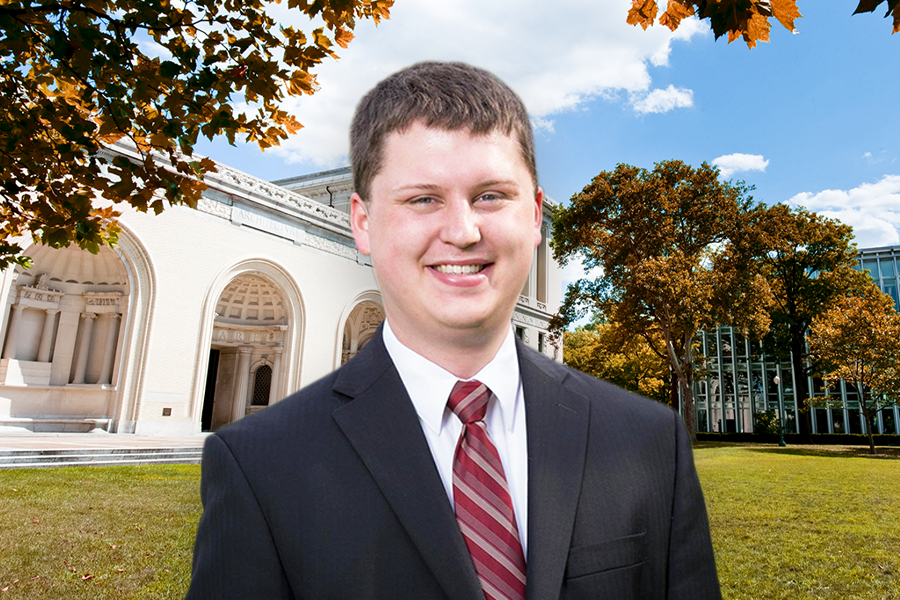
Creative Intersections of Art and Technology
From supporting cultural organizations through coronavirus challenges to reconstructing arts masterpieces, Daniel Fonner does it through a love of data and arts
By Elizabeth Speed
Alumnus Daniel Fonner has found a creative sweet spot where his talents in arts and technology can be applied to diverse projects, from supporting major cultural institutions through data and analytics to recreating artistic masterpieces destroyed by Nazis during World War II. Specifically, it’s a mission statement to be creative that’s common across his projects.
“Defining creativity means thinking of it as an intersection of unique knowledge domains. For me when I approach a project, it’s all about the inputs that make a unique output,” he says.
Unique outputs, indeed. A 2016 graduate of the Heinz College for Information Systems and Public Policy, Daniel presently is associate director for research at SMU DataArts, which connects arts and cultural leaders with high-quality data, research and insights. In his position as part of the SMU DataArts team, he gathers data from cultural and arts organizations to help them set strategy. When data sets are remixed with Daniel’s knowledge and expertise, opportunities emerge — such as studying the impact of COVID-19 on New York City’s rich fabric of arts organizations.
“We asked [arts organizations] questions related to their closures, how much money was lost, new expenses, reopening plans and federal funding. With all of this information, we were able to create a report that looked at New York City and could report on how they are faring,” he says.
The work has sparked conversations with the mayor’s office on how to help community-based organizations that fared the worst of those surveyed. The research also showed furloughs and layoffs were potentially lessening the diversity of the cultural workforce.
"Perhaps as trivial as an art collection may seem when we are talking about human life, I think there’s power providing closure to those who experienced the worst things."
“It was an amazing project because it pooled all of these elements together to tell a story,” Daniel says. “And helped to communicate, understand and create solutions to help move forward in a positive way.”
Now a resident of Dallas, Texas, where he lives with wife Staci, daughter Sydney, and a baby on the way, Daniel’s Carnegie Mellon University roots are never far. He cites his CMU-placed work/study position as a major factor in landing his present position.
“During my two years at Heinz College, I worked at the Greater Pittsburgh Arts Council. I really became grounded in doing research in this field by having that internship experience,” he says, noting that his first experiences working with data from SMU DataArts came through projects he worked on at the arts council. “I’d been using [SMU DataArts] for years to do research. It was a great experience that helped prime me for my current position.”
Daniel started his career in performing arts as a percussionist, but was drawn to study policy at Heinz College’s Masters of Arts Management program, a joint program with the College of Fine Arts, which was the genesis of the work he’s doing today.
“It’s not just a focus on management, it’s the interaction of arts and culture experience, knowledge, and course work in policy and management from Heinz College,” he says. “It seemed strange to go from being a performer to arts management to being a researcher in a university, but it all has a linear trajectory because it is the creative combination of information.”
Daniel was awarded a Fulbright Fellowship to extend other work he started at Carnegie Mellon after graduating. He used the award to create the ReMasterpieces Project. He locates archival photographs of artwork stolen or destroyed by Nazis then recreates the lost works. “Using programming skills gained as a Heinz student, I was able to dive deeper into programming and AI/machine learning and take little photos and increase resolution, add color and surface texture to recreate what these paintings probably looked like.”
Bringing unique inputs together, like a technological savvy and passion for bolstering arts, Daniel continues his creative support of arts in profound and unexpected ways. Through ReMasterpieces, he can restore an understanding of important pieces of work and return their beauty to those who’ve missed them for decades.
“Perhaps as trivial as an art collection may seem when we are talking about human life, I think there’s power providing closure to those who experienced the worst things.”